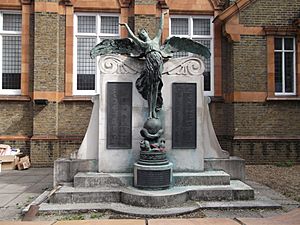Livesey Hall War Memorial facts for kids

Livesey Hall War Memorial in the Sydenham area of Lewisham
|
|
| Coordinates | 51°25′53″N -0°2′14″W / 51.43139°N 0.03722°W |
|---|---|
| Location | Lewisham, Greater London, England |
| Designer | Sydney March |
| Type | Military |
| Material | Bronze and Limestone |
| Completion date | 1920 |
| Opening date | 4 June 1920 |
| Dedicated to | Employees of South Suburban Gas Company who served in World War I and World War II |
| National Historic List for England Grade II | |
The Livesey Hall War Memorial remembers people who worked for the South Suburban Gas Company of London. It honors those who served in World War I and World War II. It also pays tribute to those employees who sadly died in these wars. A famous British sculptor named Sydney March created this important monument.
Contents
Where is the Memorial?
The Livesey Hall War Memorial is in Sydenham, a part of Lewisham, London, England. You can find it on Perry Hill, in the Bell Green neighborhood. It stands right in front of the Livesey Memorial Hall.
Why is it Called Livesey?
Both the memorial and the hall are named after Sir George Thomas Livesey (1834–1908). He was a very kind person who helped others. Sir George used to be the leader of a big gas company. The Livesey Museum for Children is also named after him!
What Does the Memorial Look Like?
The memorial has a bronze statue of a winged female figure. She has her arms stretched up and her wings spread wide. This statue represents Victory. She stands on a bronze globe that has snakes wrapped around it. This globe sits on a bronze base decorated with wreaths.
The Stone Base and Plaques
All of this is placed on a semi-circular stone base. A small bronze plaque was once attached to this base. Three steps lead up to a background of tall limestone slabs. On these slabs, there were three bronze plaques. Two were on the front and one was on the back.
The plaques on the front told us who the memorial was for. They honored the workers and leaders of the South Suburban Gas Company who died in the two world wars. The plaque on the right side of the front listed the names of those who died. It also included a famous quote from the English poet Rupert Brooke. The quote says: "If I should die, think only this of me: that there's some corner of a foreign field that is forever England. There shall be in that rich earth a richer dust concealed." The bronze plaque on the back listed the names of everyone from the company who served in World War I.
When Was the Memorial Opened?
The Livesey Hall War Memorial is sometimes called the Sydenham or Livesey War Memorial. It was officially opened on June 4, 1920. A very important British leader named Lord Robert Cecil (1864–1958) unveiled it. Lord Robert Cecil helped create the League of Nations in 1919. This was an organization that aimed to keep peace around the world. He even won the Nobel Peace Prize in 1937 for his efforts.
A Special Historic Building
The memorial is a listed building. This means it's a very important historical structure that is protected. It was added to the National Heritage List for England on April 25, 1995. Its listing was updated on August 30, 1996. Sir George Livesey's statue and the Livesey Memorial Hall are also on this special list.
Who Was the Sculptor?
The Livesey Hall War Memorial was designed and sculpted by a British artist named Sydney March. He was born in 1876 in Stoneferry, England. Sydney was one of nine children, and eight of them became artists!
Sydney March's Training and Work
When he was young, Sydney March worked as an apprentice for a sculptor who made monuments. Later, he studied at the Royal Academy Schools. He even won first prize there in 1900. Sydney March showed his art many times at a famous art show called The Exhibition of the Royal Academy of Arts.
His family set up art studios at their home in Farnborough, Kent. Sydney March created many artworks. He focused mostly on war memorials, but he also made sculptures of British kings, queens, and other important people of his time.
Other Famous Works by Sydney March
Sydney and his brothers and sisters finished the National War Memorial of Canada. They did this after their brother, Vernon March, passed away in 1930. Sydney March also created other well-known monuments. These include the Royal Inniskilling Fusiliers South African War Memorial in Northern Ireland. He also made the United Empire Loyalist Monument in Canada and the Lancaster Monument in England.
He also made smaller sculptures, like busts (head and shoulders statues). These include busts of King Edward VII and Cecil John Rhodes. You can see both of these at the National Portrait Gallery in London. Sydney March lived a long life and passed away in 1968 when he was 92 years old.
Protecting the Memorial
In October 2011, the three bronze plaques from the front of the memorial were stolen. Sometimes, valuable metal parts of monuments and other places are stolen. This is a problem that police in London have reported. People sometimes steal metal from roofs, manhole covers, and even railway cables. It's important to protect these historical items.

